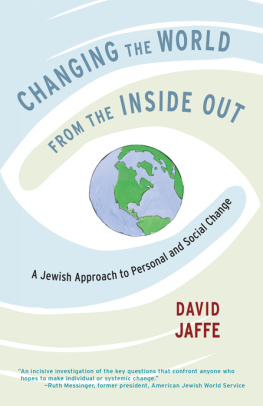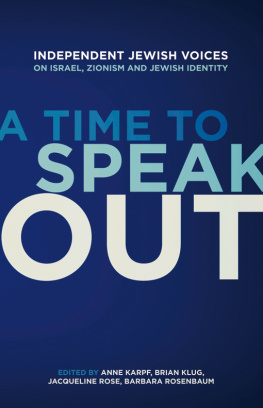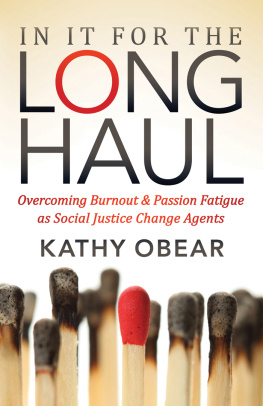Sign up to receive news and special offers from Shambhala Publications.

Or visit us online to sign up at shambhala.com/eshambhala.
This wise book is essential reading for anyone who recognizes that the worlds problems demand spiritual solutions, because it is we who must change before we can expect to change the world. Rabbi Jaffe draws on deep and time-tested Jewish wisdom to guide us to become more effective activists by bringing our highest truth to bear on public issues. He shows us how to tap the wellsprings of motivation, channel emotions, and align our behavior with our highest values to make us more effective in serving the public good. Changing the World from the Inside Out is full of valuable lessons that will help ensure that your holy light shines like a beacon in these dark times, when we need it so much.
Alan Morinis, author of Everyday Holiness
David Jaffe offers an incisive investigation into the key questions that confront anyone who hopes to make individual or systemic change. He encourages us to understand our motivations and drivesand how to use these to move toward the change we want, to help others move with us, and to not burn out in the process.
Ruth W. Messinger, former president of the American Jewish World Service
Changing the World from the Inside Out combines sweeping, idealistic visions to repair the planet with practical, realistic approaches that enable this to get done, one step at a time. It offers a path with directions how to repair ones self and grow into a kind, understanding, nurturing partner in progress.
Rabbi Yitz Greenberg, president emeritus,
The National Jewish Center for Learning and Leadership
CHANGING THE WORLD FROM THE INSIDE OUT
A Jewish Approach to Personal and Social Change
DAVID JAFFE

Trumpeter Books
An imprint of Shambhala Publications, Inc.
4720 Walnut Street
Boulder, Colorado 80301
www.shambhala.com
Cover design by Jim Zaccaria
2016 by David Jaffe
All rights reserved. No part of this book may be reproduced in any form or by any means, electronic or mechanical, including photocopying, recording, or by any information storage and retrieval system, without permission in writing from the publisher.
Wellfleet Shabbat from The Art of Blessing the Day: Poems with a Jewish Theme by Marge Piercy. Copyright 1999 by Middlemarsh Inc. Used by permission of Alfred A. Knopf, an imprint of the Knopf Doubleday Publishing Group, a division of Penguin Random House LLC. All rights reserved. Any third part use of this material, outside of this publication, is prohibited. Interested parties must apply to Penguin Random House LLC for permission.
Library of Congress Cataloging-in-Publication Data
Names: Jaffe, David L., 1965 author.
Title: Changing the world from the inside out: a Jewish approach to personal and social change / David Jaffe.
Description: First edition. | Boulder, Colorado: Shambhala, [2016] | 2016 | Includes bibliographical references and index.
Identifiers: LCCN 2015047917 | eISBN 9780834840447 | ISBN 9781611803358 (pbk.: alk. paper)
Subjects: LCSH: Spiritual lifeJudaism. | Jewish way of life.
Classification: LCC BM723 .J34 2016 | DDC 296.7dc23
LC record available at http://lccn.loc.gov/2015047917
DEDICATION
To my parents, Alan and Liz Jaffe, communal volunteers extraordinaire, who taught me the meaning of lifelong service.
NOTES TO THE READER
About the Hebrew
I occasionally refer to the Hebrew spelling of a word to show its grammatical root. For some readers the Hebrew will offer additional meaning. If you do not know Hebrew, dont worry. You can skip over the Hebrew without losing any of the basic meaning of the word or sentence. Traditional Jewish terms are transliterated throughout the book. I decided to keep the traditional terms rather than use only contemporary English translations to give the reader the option of seeing the original language used by the Mussar and Hasidic masters.
About the Stories
Most of the stories in this book use the actual names of the people and places involved. On several occasions I change the names to maintain anonymity. None of these changes compromise the underlying lessons of the story.
The genesis for this book, and my personal drive to integrate the inner life with social change, dates back to two incidents toward the end of my time in college. I was raised in a warm, highly Jewishly identified, but not particularly religious, Jewish family. Like most of my peers my bar mitzvah was the end of my religious involvement. I lived out my adolescent years as a secular, assimilated Jew in the greater New York area.
This all changed when a close childhood friend died of leukemia during my junior year of college. I was shaken out of my spiritual sleep and began to question the set path I had been onthat is, college, graduate school, professional job, family, children. I knew there had to be more to life than the search for a high-paying job that occupied most of my peers just after college. I turned down law-school acceptances and headed out West. I needed physical and emotional space from everything I knew to explore this yearning for deep connection and transcendence that had only recently awakened in me.
I spent the next two years in spiritual turmoil traversing the landscape of popular Jewish mysticism and Buddhism until I found my way to observant Judaism and a disciplined relationship with God. By my mid-twenties spiritual practice was a central part of my life.
At the same time, I awoke politically. My parents and grandparents were wonderful role models of communal volunteers, both in the Jewish and general communities. I always knew I needed to be involved in and give back to the community and lived this out by volunteering consistently from the time I was sixteen. At the same time, I was asleep to the larger issues of social and institutional oppression around me.
My political awakening began during the last semester of my senior year when my fraternity was kicked off campus for four years due to sexual harassment. I joined this particular fraternity at age eighteen out of hope that it would give me the social status and popularity that I felt had eluded me in high school. I soon found out that the fraternity glorified the mistreatment of women. My friends and I would comment privately how wrong this behavior was, but none of us ever spoke publicly or did anything about it, in the meantime remaining members of the fraternity. During my senior year, a date rape case at the fraternity was a cause clbre on campus all spring, culminating in the house being shut down for the next four years.
During the case I was dating a feminist woman who challenged me to speak out against my fraternity. I responded, But in general they are good guys. I knew that mistreating women was wrong. I felt strongly about the mistreatment of individuals, but I couldnt make the connection to ending oppression in the systemin this case, the fraternity.
Shortly after the fraternity was kicked off campus, I sat down to eat in my favorite caf wearing the fraternity baseball cap. The waitress rudely slammed down my food on the table. When I asked what was going on, she told me that wearing that hat in the caf would be like her wearing a swastika into a Jews restaurant. My first reaction was anger: how can you make that comparison! I huffed out not leaving a tip. By the time I got to my car, it hit me. If she could feel that strongly about what had happened, comparing us to Nazis, there really had to be something deeply wrong with my fraternity.
Next page










